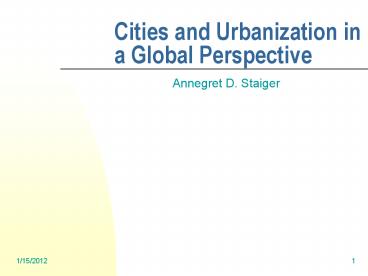Cities and Urbanization in a Global Perspective - PowerPoint PPT Presentation
1 / 22
Title:
Cities and Urbanization in a Global Perspective
Description:
Jakarta, Indonesia 11.5. Buenos Aires, Argentina 11.0. Source: United Nations. 1995. ... Jakarta, Indonesia 21.2. Sao Paulo, Brazil 20.8. Karachi, Pakistan ... – PowerPoint PPT presentation
Number of Views:354
Avg rating:3.0/5.0
Title: Cities and Urbanization in a Global Perspective
1
Cities and Urbanization in a Global Perspective
- Annegret D. Staiger
2
Introduction
- Placing cities historically and globally
3
Topics of Discussion
- 1) Kingsley Davis (1965) Theory of Urbanization
- 2) Cities in the year 2000 (links on website)
4
1) Kingsley Davis (1965) Theory of Urbanization
- First cities 5,500 yrs ago
- Rapid growth of urbanization in last 100 yrs only
- Prediction by 1990, 50 of world population will
be urban - Index of urbanization used urban if 100.000
people or more in a city
5
a) Definition of Urbanization
- Proportion of countrys population in urban
settlements - Urban population vs population growth
- Urban spill-over (sprawl) makes definition of
urban more difficult
6
b) Degree of urbanization in whole societies
- Urbanized societies arose in NW Europe, not the
Tigris/Euphrates - Obstacles for growth
- Low agricultural productivity
- Feudal social system
- With industrialization, urbanization takes off
7
S-Curve of Urbanization
- Example UK
- 1811-1851
- S curve flattens when urbanization reaches 50,
and bottoms out at 75 - The S-curve graphically
8
Where do the Urbanites come from?
- A) proportion in cities larger because rural
towns grow larger and become cities? - B) excess of births over deaths in city in
contrast to country? - C) people move from country to city?
9
Rural-Urban Migration
- Why?
- Agricultural modernization uses more land/capita
- Requires more capital
- Makes it less accessible for rural folks
- Urbanized societies show shift from agricultural
to non-agricultural employment
10
At the end of the S-Curve
- The proportion of rural population is too small
to provide enough people to cities to sustain a
steady degree of urbanization - End of urbanization does not mean the end of city
growth - Example Japan decreasing urbanization but cities
grow by 50
11
Does Urbanization in Underdeveloped Nations
Mirror the Experience of Industrialized Nations?
- No cities there grow much faster
- 1940s-50s
- More than 4 average annual gain in developing
nations - Compared to 2 average annual gain in
industrialized nations heyday of urbanization - Cause is not urban-rural migration but instead
- Natural population growth in country as a whole
- Developing country cities have improved mortality
rates and only slightly lower fertility - No decline in rural population, as occurred in
developed countries - Problem the rapidly growing population in
countryside has been absorbed to a good extent by
cities, leaving country side to be farmed more
productively, and cities are taking care of some
of the problems associated with fast-growing
population - Rapid growing population requires the same amount
of land to feed more people than before
12
Graphic Changes
- se
13
How contemporary Third World Cities differ from
European Citys urban transformation
- Todays Third World Cities Growth is unhinged
from - Countrys economic development
- Their urban growth does not contribute to
economic advancement as it did to industrialized
cities development - Predicts that largest city in India will have
30-60 mio by 2000
14
A) What does Kingsley Davis see as the main
problem for the future of cities?B) Was he
right with his predictions?
15
Global Change not only of the Natural
environment, but also, the Built Environment
- Cities as symbols of transforming economies and
societies - Includes changing social and economic relations
in our world - A majority of people will live in urban
environments - MDC 75 in urban
- LDC 37 in urban
16
Worlds Largest Cities 1995
- Table 1 The Worlds 25 Largest Cities, 1995
- Country
- Population (millions)
- Tokyo, Japan 26.8
- Sao Paulo, Brazil 16.4
- New York, USA 16.3
- Mexico City, Mexico 15.6
- Bombay, India 15.1
- Shanghai, China 15.1
- Los Angeles, USA 12.4
- Beijing, China 12.4
- Calcutta, India 11.7
- Seoul, Republic of Korea 11.6
- Jakarta, Indonesia 11.5
- Buenos Aires, Argentina 11.0
- Source United Nations. 1995. World urbanization
prospects 1994 revisions. New York, NY UN,
pp. 132-139 and 143-150. Reprinted with the
permission of the United Nations Department of
Public Information.
17
Projected Largest Cities by 2025
- Urban Agglomeration inPopulation(in Millions)
- Tokyo, Japan 28.7
- Bombay, India 27.
- Lagos, Nigeria 24.4
- Shanghai, China 23.4
- Jakarta, Indonesia 21.2
- Sao Paulo, Brazil 20.8
- Karachi, Pakistan 20.6
- Beijing, China 19.4
- Dhaka, Bangladesh 19
- Mexico City, Mexico 18.8
- New York, USA 17.6
- Calcutta, India 17.6
- Delhi, India 17.6
- Tianjin, China 14.7
- Metro Manila 14.7
- Source United Nations. 1995. World urbanization
prospects. New York United Nations
Publication, p. 3. Reprinted with the permission
of the United Nations.
18
(No Transcript)
19
Los Angeles at Night
20
Bangladesh Slum Clearance
21
Recycling as a Way of Life - Waste Collecting as
Survival in Lagos, Nigeria
22
Petrona Towers
- Petrona Towers,
- Kuala Lumpur, Malaysia































